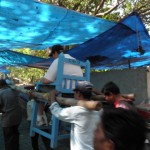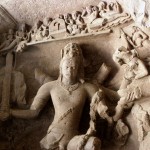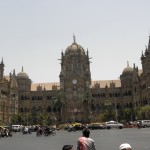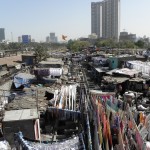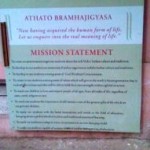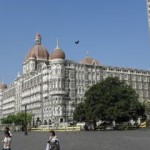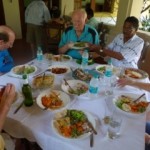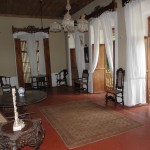- Juma Beach From the Hotel
- Gathering at the Gateway
- Backward Glance at the Raj
- Gateway from the Ferry
- Fellow Ferry Passenger
- Ferry Just Arrived
- Pleasure Run Aground
- Bold Unofficial Greeter
- Mom Ready to Accost Visitors with Baby as Lure
- Bold Ready to Pounce
- Just Stole My Water
- Our Ancestral Roots
- Raj Up
- Entry
- Listening to History in the Main Sacred Hall
- Enormous Carvings on Every Wall
- Celebration of Shiva Story
- Outside the Main Sacred Gallery
- To Look Like Rooms
- Details Tell the Tale
- Raj Jordan Headed Down to Ferry
The island of Elephanta, an hour ferry ride from Mumbai, is described on the UNESCO website as “the glorious abode of Lord Shiva.” The seven caves at the site are considered the epitome of Hindu cave culture. Images from Hindu mythology pantheon decorate the temples.
The date of the Elephanta Caves is debated and varies from the 6th century to the 8th century based on the findings of different archeologists. The caves constitute one of the most striking collections of rock art in India.
There are two groups of caves. The main cave, famous for its carvings to the glory of Shiva, consists of a square hall plan with the interior divided into smaller areas by rows of supports. This interior space carefully imitates a building. False profiled beams have been carved into the roof and the supports are in the shapes of the pillars, columns and capitals prevalent in stone architecture. Colossal figures of dvarapala guardians flank the entry. Enormous high-reliefs depicting the life of Shiva are on each wall of the vast square sacred assembly space. Ten other reliefs, placed in each angle of the main hall and in the aisles to the east and west, depict further episodes from the legend of Shiva, such as the marriage of Shiva to Parvati, Shiva killing the devil Andhaka. Additionally the 15 large reliefs surrounding the lingam chapel in the main Elephanta Cave not only constitute one of the greatest examples of Indian art but also one of the most important collections for the cult of Shiva.
A popular destination, visitors include locals on day excursions, Indian tourists as well as tourists worldwide. Although they come for the caves, all visitors are fascinated by the the bold and very aggressive pack of monkeys that will steal anything from anyone at any moment. Although I was very cautious after warnings from our guide, sure enough I lost my water bottle on which Mama Monkey promptly unscrewed the lid and gave Baby a drink. Maybe cute but it was alarming for me!!!!
Source: UNESCO












